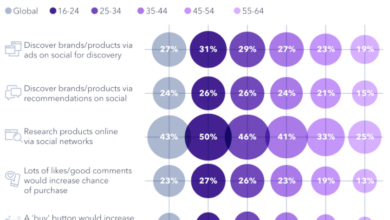
Facebook Ad Secrets Success Strategy
The secret to a successful Facebook ad strategy that no one tells you unlocks the hidden potential of Facebook advertising. This in-depth guide reveals the nuances of crafting compelling campaigns, optimizing targeting, and maximizing your budget for maximum ROI. We’ll explore everything from understanding the Facebook ad landscape to building a scalable strategy that adapts to changing market trends.
From identifying your ideal audience to mastering A/B testing, we’ll cover the practical steps and critical insights needed to navigate the complexities of Facebook advertising. We’ll equip you with the knowledge to create effective ad copy, leverage powerful targeting options, and optimize ad delivery for the best results. This is not just about following the trends, but understanding the underlying principles of success.
Understanding the Facebook Ad Landscape
Facebook advertising is a powerful tool for businesses of all sizes, but navigating the constantly evolving landscape can be daunting. This guide cuts through the noise and reveals the core strategies that successful advertisers employ. From understanding the intricacies of ad formats to mastering audience targeting and campaign optimization, we’ll equip you with the knowledge to maximize your Facebook ad ROI.The current Facebook ad landscape is characterized by a diverse range of ad formats, allowing for targeted campaigns across various demographics and interests.
Understanding these options is crucial to crafting effective strategies that resonate with your specific audience. Misinterpreting these formats and targeting options can result in wasted ad spend and limited return on investment. This guide helps you avoid such pitfalls.
Popular Ad Formats
Facebook offers a variety of ad formats to cater to different marketing goals and audience engagement styles. Image ads, video ads, carousel ads, and collection ads are some of the most common formats. Each format offers unique advantages in terms of visual appeal, interactivity, and call-to-action opportunities. Understanding the strengths and weaknesses of each format is essential for selecting the most effective option for your campaign.
- Image Ads: Simple, visually engaging ads that are effective for conveying a message or highlighting a product quickly. Their simplicity allows for rapid creation and deployment, but they might not be as compelling as more dynamic formats.
- Video Ads: Video ads can capture attention and convey more complex information. They allow for storytelling and showcasing products in action, making them highly effective for brand building and product demonstrations. However, they require more time and resources to create compared to image ads.
- Carousel Ads: These ads showcase multiple images or videos in a scrollable format. This allows for showcasing multiple products or different aspects of a single product, increasing engagement and conversion potential. A well-structured carousel ad can showcase multiple angles of a product and highlight its features.
- Collection Ads: Ideal for e-commerce, collection ads feature products in a visually appealing format. They allow users to easily browse and purchase items directly within the ad, streamlining the buying process. They are especially valuable for businesses looking to drive sales.
Targeting Options
Facebook’s targeting options are vast and customizable, enabling precise audience segmentation. Demographic data, interests, behaviors, and connections are key aspects that can be utilized to reach the ideal customer. This granular control allows for optimizing ad spend and avoiding irrelevant impressions.
- Demographic Targeting: Reaching specific age groups, genders, locations, and income levels allows for focused ad delivery. This approach is particularly beneficial for products or services tailored to particular demographic preferences.
- Interest Targeting: Focusing on users’ interests and hobbies enables highly targeted advertising. Understanding your target audience’s interests allows you to create ads that resonate deeply with them. Examples include targeting users interested in cooking, fitness, or gaming.
- Behavioral Targeting: Targeting based on user actions and online behavior, such as website visits, app usage, or purchase history, provides a highly refined approach. This allows you to target users who have demonstrated interest in similar products or services. For example, a company selling hiking gear could target users who have visited hiking-related websites.
- Custom Audiences: Leveraging email lists, customer data, or website visitors, custom audiences create highly specific and relevant targeting. This allows for re-engaging existing customers or reaching potential customers who have shown interest in your products.
Common Pitfalls
Advertisers often fall into traps that lead to low returns. These include not clearly defining the target audience, creating generic ad copy, and failing to track campaign performance. Careful consideration of these pitfalls can prevent wasted resources and optimize ad spend.
- Generic Ad Copy: Avoid creating ads that lack a specific focus. Tailoring the message to resonate with the target audience and highlighting the unique value proposition is essential for maximizing ad effectiveness.
- Inadequate Audience Definition: Not precisely defining the target audience leads to ineffective targeting. Defining a clear target audience with specific demographics, interests, and behaviors is crucial for reaching the right users.
- Ignoring A/B Testing: Not testing different ad creatives and targeting strategies can result in suboptimal performance. A/B testing allows for identifying the most effective ad versions, optimizing ad copy, and increasing conversion rates.
A/B Testing
A/B testing is a critical element of Facebook ad optimization. It involves creating variations of ads and measuring their performance. Testing different headlines, images, calls to action, and targeting parameters helps in refining the campaign and achieving the best possible results. By testing different versions of ads, you can determine which ones are most effective at engaging your target audience and driving conversions.
Facebook Ad Campaign Objectives
Different campaign objectives offer varying strengths and weaknesses. Understanding these objectives helps advertisers align their campaigns with specific goals, whether it’s driving website traffic, increasing app installs, or generating leads. By understanding the nuances of each objective, advertisers can make informed decisions about campaign design and structure.
- Website Conversions: This objective focuses on driving traffic to your website and encouraging conversions, such as completing a purchase or form submission. It’s crucial for businesses looking to drive sales or collect leads.
- App Installs: This objective is designed to increase the number of app installations. It’s ideal for mobile-first businesses or apps looking to expand their user base.
- Brand Awareness: This objective is designed to increase brand recognition and visibility. It’s effective for building brand presence and reaching a wider audience.
Crafting Compelling Ad Creative
Beyond understanding your audience and the Facebook ad landscape, crafting compelling ad creative is crucial for success. This involves more than just slapping up a picture and some text. Effective ad copy and visuals are meticulously designed to capture attention, convey value, and ultimately drive conversions. This section dives deep into the art of crafting ads that resonate with your target audience.
Designing Compelling Ad Copy
Ad copy is the heart of your Facebook ad. It needs to immediately grab attention and then effectively communicate the value proposition of your product or service. The copy should be concise, clear, and persuasive. Headlines and descriptions are key components of a compelling ad, and their design is critical.
Crafting Attention-Grabbing Headlines
A strong headline is the first impression your ad makes. It needs to pique interest and encourage clicks. Avoid generic phrases and opt for headlines that are specific, benefit-driven, and intriguing. Consider using numbers, questions, or powerful verbs to make your headlines stand out. For example, “Boost Your Sales by 25% with These 5 Strategies” is more compelling than “Sales Strategies.”
Writing Value-Driven Ad Descriptions
The description expands on the headline, providing more context and details about the offer. Focus on the benefits for the customer, not just the features of your product. Highlight specific problems the product solves and how it improves the customer’s life. Avoid jargon and technical terms. Use clear, concise language that resonates with your target audience.
A good description should answer the questions a potential customer might have.
Leveraging High-Quality Visuals and Videos
Visuals and videos are crucial for grabbing attention and conveying your message effectively. High-quality images and videos that are relevant to your product or service, and aligned with your brand, will make a significant impact on your ad’s performance. Ensure that your visuals are visually appealing and evoke the desired emotions. A well-designed image or video can be worth a thousand words.
Organizing a Series of Facebook Ad Visuals
A series of Facebook ads should tell a consistent story. Visuals should be cohesive and complement the ad copy. If you’re running multiple ads, maintain a similar visual style and color palette across the series. Consider using a visual theme or a recurring motif to reinforce brand recognition and create a memorable experience for the viewer. Think of a cohesive narrative that the visuals support, guiding the user through the different phases of the product’s value proposition.
Different Ad Copy Styles
| Ad Copy Style | Pros | Cons |
|---|---|---|
| Benefit-Driven | Highlights customer benefits, focuses on solutions | Can be less specific about features |
| Problem/Solution | Clearly defines the problem and presents the solution | May not be engaging enough if the problem is not relatable |
| Intriguing/Question-Based | Captures attention, encourages interaction | Requires careful wording to avoid sounding too generic or insincere |
| Direct/Commanding | Clear call to action, concise and powerful | Can be perceived as aggressive or pushy if not used appropriately |
Optimizing Targeting Strategies: The Secret To A Successful Facebook Ad Strategy That No One Tells You

Facebook ads are only as effective as your targeting. Knowing your ideal customer intimately allows you to craft highly relevant ads, minimizing wasted ad spend and maximizing ROI. This crucial step involves understanding not just
- who* your customer is, but
- how* Facebook’s targeting tools can help you reach them precisely.
Effective targeting is the bridge between your product and your ideal customer. It’s the key to ensuring your ads resonate with the right people, leading to increased conversions and a healthier bottom line. By mastering the art of Facebook targeting, you unlock the potential for exponential growth.
Defining Your Ideal Customer Profile (ICP), The secret to a successful facebook ad strategy that no one tells you
Understanding your ideal customer profile (ICP) is paramount to successful targeting. A well-defined ICP helps you create highly targeted campaigns that resonate with your ideal customer. This process involves identifying demographics, interests, behaviors, and needs of your target audience. Thorough research and analysis of your existing customer base, market trends, and competitor strategies are crucial to developing a comprehensive ICP.
Leveraging Facebook’s Targeting Options
Facebook offers a diverse range of targeting options to help you reach your ideal customer. These options allow you to segment your audience based on various criteria. Mastering these tools is key to maximizing campaign effectiveness. You can refine your targeting to reach specific age groups, locations, interests, behaviors, and even connections to your brand.
Lookalike Audiences for Expanded Reach
Lookalike audiences are a powerful tool for expanding your reach and identifying potential customers. They allow you to find new users who are similar to your existing customers, based on their demographics, interests, and behaviors. This strategy is particularly effective for businesses seeking to acquire new customers.
Creating Custom Audiences
Custom audiences allow you to reach users who have already interacted with your brand. This is a highly effective strategy for retargeting website visitors and email subscribers. This ensures that your ads are seen by individuals who have shown interest in your product or service.
- Website Traffic Custom Audiences: Import website visitors into Facebook to retarget them with ads. This is crucial for reminding them of your products and driving conversions. It allows you to re-engage users who showed interest in your website but didn’t make a purchase.
- Customer List Custom Audiences: Upload your existing customer email lists to Facebook to retarget them. This is a direct way to re-engage loyal customers and promote new products or services.
Refining Targeting Strategies Based on Campaign Performance Data
Campaign performance data is invaluable for refining your targeting strategies. Regularly monitor key metrics such as click-through rates (CTRs), conversion rates, and cost-per-acquisition (CPA). Adjust your targeting parameters based on the performance data, identifying what works and what doesn’t. Analyze the data and identify areas for improvement.
Comparing Facebook Targeting Options and Costs
The cost of Facebook targeting options varies significantly depending on the specificity of your targeting criteria. The table below provides a general comparison:
| Targeting Option | Description | Typical Cost (Example) |
|---|---|---|
| Detailed Targeting | Precise targeting based on demographics, interests, behaviors, and more. | $0.50 – $2.00 per click |
| Custom Audiences | Targeting users who have interacted with your business (website, email). | $0.25 – $1.50 per click |
| Lookalike Audiences | Targeting users similar to your existing customers. | $0.30 – $1.75 per click |
| Interests Targeting | Targeting users based on their interests. | $0.40 – $1.80 per click |
Note: Costs are examples and can vary based on competition, ad quality, and other factors.
Optimizing Ad Delivery and Budget Allocation
Facebook ad success isn’t just about creating compelling ads and targeting the right audience. It’s about efficiently using your budget and ensuring your ads reach the maximum number of qualified prospects. This crucial aspect of Facebook advertising often gets overlooked, but mastering it can significantly improve your return on investment (ROI).Effective ad delivery optimization and intelligent budget allocation are key to maximizing your Facebook ad campaign’s impact.
Understanding how to adjust your spend based on performance data and strategically allocate resources across different ad sets and campaigns allows you to achieve better results with your existing budget. This involves a continuous monitoring and refinement process, allowing you to identify and avoid wasted ad spend.
Ad Delivery Optimization: Maximizing Impact
Optimizing ad delivery involves fine-tuning various parameters within the Facebook Ads Manager to ensure your ads reach the most relevant audience at the optimal times. This process goes beyond basic targeting and includes factors like ad placement, bid strategies, and audience engagement. This leads to improved ad performance, higher click-through rates (CTR), and ultimately, more conversions. By leveraging Facebook’s sophisticated algorithms, you can ensure your ads are seen by the most receptive audience.
Adjusting Ad Spend Based on Performance Data
Analyzing performance data is crucial for informed decisions about your ad spend. Key performance indicators (KPIs) like CTR, conversion rates, cost per acquisition (CPA), and return on ad spend (ROAS) provide insights into the effectiveness of different ad sets and campaigns. Adjusting your ad spend based on these metrics allows you to reallocate funds from underperforming campaigns to high-performing ones.
For instance, if one ad set consistently generates a higher conversion rate at a lower CPA than others, increasing the budget for that ad set can be highly beneficial.
Budget Allocation Framework
A well-defined framework for allocating your budget across ad sets and campaigns is essential for optimal results. Consider factors like campaign objectives, target audience segments, and expected outcomes when establishing your budget allocation strategy. A flexible framework that adapts to changing performance data is more effective than a rigid approach. For instance, a new campaign might begin with a lower budget for testing, then increase the allocation based on initial performance.
Continuous Monitoring and Adjustment
Continuous monitoring of campaign performance is paramount for success. Regularly review KPIs to identify trends, spot underperforming areas, and make necessary adjustments. This proactive approach allows you to quickly adapt to changes in the Facebook ad landscape, maintaining a high level of efficiency and optimizing your budget allocation. Monitoring also enables you to quickly identify and address any potential issues, minimizing wasted ad spend.
Identifying and Avoiding Wasted Ad Spend
Wasted ad spend can significantly impact your ROI. Understanding the reasons for underperformance is crucial. Factors such as irrelevant targeting, poor ad copy, or inappropriate bidding strategies can lead to wasted ad spend. Thoroughly analyzing performance data, identifying trends, and refining your strategy will help you to avoid these pitfalls. By closely monitoring your ad spend and adjusting your targeting, you can prevent wasted ad dollars.
Budget Allocation Strategies
| Strategy | Description | Suitable for |
|---|---|---|
| Proportional Allocation | Distribute budget proportionally based on the estimated reach of each ad set. | Campaigns with multiple ad sets targeting distinct demographics or interests. |
| Performance-Based Allocation | Allocate budget based on the performance of each ad set (e.g., higher conversion rates receive more budget). | Campaigns with measurable conversions and ROI. |
| A/B Testing Allocation | Allocate a portion of the budget to test different ad creatives, targeting options, and ad copy variations. | Campaigns looking to optimize ad performance and identify the most effective strategies. |
Measuring and Analyzing Campaign Performance
Knowing what’s working and what’s not in your Facebook ad campaigns is crucial for maximizing return on investment (ROI). Without meticulous tracking and analysis, you’re essentially flying blind, wasting ad spend on ineffective strategies. This crucial step allows you to refine your approach, optimize your budget, and achieve better results over time.
Importance of Tracking Key Metrics
Understanding the performance of your Facebook ad campaigns is essential for continuous improvement. Tracking key metrics provides insights into user engagement, ad effectiveness, and overall campaign ROI. This data allows you to identify areas needing improvement, optimize your strategies, and ultimately, maximize your ad spend. Without these metrics, you are operating in the dark, potentially squandering resources on ineffective tactics.
Methods for Analyzing Campaign Performance Data
Analyzing Facebook ad campaign data involves several methods. First, thoroughly review the Facebook Ads Manager reports. These reports offer detailed breakdowns of campaign performance, including impressions, clicks, conversions, and cost per action. Second, use third-party analytics tools to gain a deeper understanding of campaign performance. These tools often provide more granular data and advanced visualization capabilities.
Finally, compare your campaign data to industry benchmarks and competitor data to understand your performance relative to the market. This context allows for objective assessments and provides actionable insights for improvements.
Using Facebook Ads Manager for Comprehensive Analysis
The Facebook Ads Manager is your primary tool for comprehensive campaign analysis. It provides a wealth of data, including detailed performance reports for individual ads, campaigns, and even ad sets. Understanding the various reports within the Ads Manager is crucial. By exploring these reports, you can identify trends, pinpoint areas for improvement, and adjust your strategy in real-time.
These insights are invaluable for fine-tuning your campaigns and achieving better results.
Identifying and Addressing Underperforming Ads and Campaigns
Identifying underperforming ads and campaigns requires a methodical approach. First, analyze the data within the Facebook Ads Manager. This includes examining the performance of individual ads, ad sets, and campaigns. Second, identify the common characteristics of underperforming ads. Look for patterns in ad copy, visuals, targeting, and bidding strategies.
Once you’ve identified these patterns, adjust your approach accordingly, testing new variations to see if performance improves.
So, the secret to a killer Facebook ad strategy? It’s not just about fancy visuals or catchy captions. It’s about understanding your target audience deeply. And, let’s be honest, sometimes the best ideas come from unexpected places. Check out these 11 real estate marketing ideas they’ll work, 11 real estate marketing ideas they’ll work , for some real-world inspiration.
Ultimately, a successful Facebook ad strategy needs a good understanding of your audience and some creative marketing tactics, like those in the article. That’s the real secret.
Understanding the Relationship Between Ad Spend and ROI
Understanding the relationship between ad spend and ROI is critical for optimizing your Facebook ad campaigns. A high ad spend doesn’t automatically equate to a high ROI. Careful optimization and targeting are essential to maximize the return on your investment. Analyze the cost per conversion, the conversion rate, and the lifetime value of customers acquired through your ads.
The secret to a successful Facebook ad strategy that no one tells you? It’s not about fancy visuals or clever captions, it’s about understanding your audience’s search behavior. Fortunately, new tools like new Google Ads insights pages takes the guesswork out of search trends are making this much easier. By pinpointing current search trends, you can tailor your Facebook ads to resonate with the right people, maximizing your campaign’s ROI and getting the most out of your ad spend.
This deep dive into user search behavior is key to any effective Facebook ad strategy.
This comprehensive analysis allows for a more informed decision-making process regarding budget allocation.
Essential Facebook Ad Metrics
Regularly monitoring these key metrics is crucial for effective campaign management. Understanding their significance allows for data-driven decision-making, enabling you to refine strategies for improved ROI.
Unlocking the secret to a successful Facebook ad strategy often boils down to understanding your audience’s needs. One key element, often overlooked, is connecting your ads to high-impact online activities, like the ones detailed in this fantastic guide on how to make $170,000 with online challenges or events how to make 170000 with online challenges or events.
By aligning your ad campaigns with proven engagement strategies, you can dramatically increase your chances of success, ultimately leading to a winning Facebook ad strategy.
| Metric | Description | Importance |
|---|---|---|
| Impressions | The number of times your ad was shown. | Indicates ad visibility and potential reach. |
| Clicks | The number of times your ad was clicked. | Measures user engagement and interest. |
| Conversion Rate | The percentage of clicks that resulted in a desired action (e.g., purchase, sign-up). | Highlights ad effectiveness in driving conversions. |
| Cost per Click (CPC) | The average cost of each click on your ad. | Essential for budget management and optimizing bids. |
| Cost per Acquisition (CPA) | The average cost of acquiring a customer. | Directly links ad spend to the value generated. |
| Return on Ad Spend (ROAS) | The revenue generated for every dollar spent on ads. | The ultimate measure of ad campaign profitability. |
Building a Scalable Strategy
Turning a successful Facebook ad campaign into a consistent revenue stream requires a scalable strategy. This isn’t about just running ads; it’s about building a system that adapts, optimizes, and grows with your business. A well-defined scaling plan ensures your ad spend aligns with your growth goals and allows for continuous improvement. This section will provide a roadmap to achieve that scalability.Initial success often points to a viable strategy, but merely replicating past successes isn’t enough.
Market trends evolve rapidly, and staying ahead demands continuous adaptation. This includes not just monitoring but proactively adjusting your targeting, creative, and even your overall campaign objectives. A scalable strategy incorporates the flexibility to adapt to changing conditions.
Creating a Roadmap for Scaling Campaigns
A structured approach is essential for scaling campaigns effectively. Begin by identifying key performance indicators (KPIs) that directly contribute to your business goals. These metrics, whether it’s conversion rates, customer acquisition cost (CAC), or return on ad spend (ROAS), should be regularly tracked and analyzed. Understanding what drives your success allows for informed adjustments. Document your winning ad sets, targeting parameters, and creative elements.
This documented success is a crucial starting point for replication and expansion.
Adapting to Changing Market Trends
Market trends, especially in the digital realm, are dynamic. Staying current with emerging platforms, audience preferences, and competitor strategies is paramount. Leverage social media listening tools and market research to anticipate shifts. Analyzing competitor campaigns can reveal insights into what’s working and what’s not. Continuously monitoring industry news and relevant publications helps you identify emerging trends and potential challenges.
Proactive adaptation is crucial for sustained success.
Implementing a System for Ongoing Optimization
A robust optimization system is critical. Regular A/B testing, not just of ads, but of targeting and ad placements, is key. Analyze data meticulously, identifying patterns, and making data-driven decisions. Establish a clear process for reviewing campaign performance on a scheduled basis. This could be weekly or bi-weekly depending on the campaign size and complexity.
Create a feedback loop where insights are shared and implemented to improve future campaigns.
Leveraging Automation Tools for Scaling
Automation tools can significantly streamline the management and scaling of campaigns. Tools that automate ad creation, targeting, and bidding can free up valuable time and resources. Utilize these tools to maintain consistent campaign performance as you scale. Choose tools that align with your budget and technical expertise. Remember that automation is a tool to enhance efficiency, not replace human oversight.
Regularly monitor and adjust automated processes to ensure they remain aligned with your objectives.
Maintaining High-Quality Ad Creative and Targeting
As campaigns grow, maintaining high-quality creative and targeting is crucial. Consistent branding and messaging across all ad units are essential for maintaining brand recognition and building trust. Segment your audience based on precise characteristics. Avoid generic or broad targeting, as it dilutes your message and increases your cost per acquisition. Invest in high-quality imagery and compelling video content.
Maintain brand consistency while still adapting to specific audience segments.
Illustrative Example of a Scalable Facebook Ad Campaign Structure
| Campaign Name | Objective | Ad Sets | Ads |
|---|---|---|---|
| Lead Generation for New Software | Generate leads for a new software product |
|
|
This example demonstrates a simple, yet scalable structure. Each campaign element can be further broken down and refined to optimize performance. This structure allows for expansion by adding new ad sets and ads targeting different audience segments.
Last Word

Unlocking the secret to successful Facebook ad strategies involves more than just trial and error. This comprehensive guide provides a roadmap to navigate the Facebook advertising landscape. By understanding the nuances of ad creation, targeting, and campaign optimization, you can transform your Facebook ad campaigns into powerful revenue generators. Continuous learning and adaptation are key to achieving long-term success in the dynamic world of Facebook advertising.





